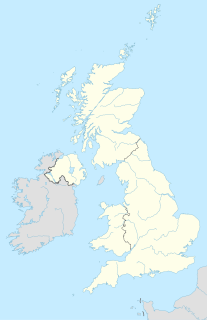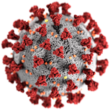
A ventilator is a machine that provides mechanical ventilation by moving breathable air into and out of the lungs, to deliver breaths to a patient who is physically unable to breathe, or breathing insufficiently. Modern ventilators are computerized microprocessor-controlled machines, but patients can also be ventilated with a simple, hand-operated bag valve mask. Ventilators are chiefly used in intensive-care medicine, home care, and emergency medicine and in anesthesiology.

An epidemic curve, also known as an epi curve or epidemiological curve, is a statistical chart used in epidemiology to visualise the onset of a disease outbreak. It can help with the identification of the mode of transmission of the disease. It can also show the disease's magnitude, its outliers, its trend over time, and its incubation period. It can give outbreak investigators an idea as to whether an outbreak is likely to be from a point source, a continuous common source, or a propagated source.

Coronavirus disease 2019 (COVID-19) is an infectious disease caused by severe acute respiratory syndrome coronavirus 2 (SARS-CoV-2). It was first identified in December 2019 in Wuhan, China, and has since spread globally, resulting in an ongoing pandemic. As of 20 May 2020, more than 4.96 million cases have been reported across 188 countries and territories, resulting in more than 326,000 deaths. More than 1.88 million people have recovered.

The COVID-19 pandemic was confirmed to have reached Bahrain on 21 February 2020.

The COVID-19 pandemic saw its first three confirmed cases in the Czech Republic on 1 March 2020. On 12 March, the government declared a state of emergency, for the first time in the country's modern history for the area of the entire country. On 16 March, the country closed its borders, forbade the entry of foreigners and issued a nationwide curfew. While originally planned until 24 March, the measures were later extended until 1 April and then again until the end of State of Emergency which was extended by the Chamber of Deputies until 30 April 2020 and then again until 17 May 2020.
Syra Madad is an American pathogen preparedness expert. Madad is the Senior Director of the System-wide Special Pathogens Program at NYC Health + Hospitals where she is oversees New York City's response to the Coronavirus disease 2019 pandemic in the city's 11 public hospitals. She was featured in the Netflix documentary series Pandemic: How to Prevent an Outbreak.
The COVID-19 pandemic in the Bailiwick of Jersey is part of an ongoing global pandemic of coronavirus disease 2019 (COVID-19), a novel infectious disease caused by severe acute respiratory syndrome coronavirus 2 (SARS-CoV-2). The first case in Jersey was confirmed on 10 March 2020 when a person tested positive on the island after returning from Italy.

During the COVID-19 pandemic, human rights violations including censorship, discrimination, arbitrary detention, xenophobia were reported from different parts of the world. Amnesty International has responded that "Human rights violations hinder, rather than facilitate, responses to public health emergencies, and undercut their efficiency." The World Health Organization has stated that stay-at-home measures for slowing down the pandemic must not be done at the expense of human rights.
This article documents the timeline of the COVID-19 pandemic in Pakistan.

The COVID-19 pandemic was confirmed to have reached the United States territory of Guam on March 15, 2020. As of May 20, 2020, there have been 154 confirmed cases, 125 recoveries, and five deaths.

The COVID-19 pandemic was first confirmed to have spread to Scotland on 1 March 2020 with the positive COVID-19 test of a male Tayside resident who had recently travelled between Scotland and northern Italy. The first reported coronavirus death in Scotland was on 13 March 2020.
Medical materials and other goods shortages caused by the COVID-19 pandemic quickly became a major issue of the pandemic. The matter of pandemic-related shortage has been studied in the past and has been documented in recent events. On the medical side, shortages of personal protective equipment such as medical masks, gloves, face shields, gear, sanitising products, are also joined by potential shortage of more advanced devices such as hospital beds, ICU beds, oxygen therapy, ventilators and ECMO devices. Human resources, especially in terms of medical staff, may be drained by the overwhelming extent of the epidemic and associated workload, together with losses by contamination, isolation, sickness or mortality among health care workers. Territories are differently equipped to face the pandemic. Various emergency measures have been taken to ramp up equipment levels such as purchases, while calls for donations, local 3D makers, volunteer staffing, mandatory draft, or seizure of stocks and factory lines have also occurred. Bidding wars between different countries and states over these items are reported to be a major issue, with price increases, orders seized by local government, or cancelled by selling company to be redirected to higher bidder. In some cases, medical workers have been ordered to not speak about these shortages of resources.

The NHS Nightingale Hospital London is the first of the NHS Nightingale Hospitals: temporary hospitals set up by NHS England for the COVID-19 pandemic. It is housed in the ExCeL London convention centre in East London, and has an initial capacity for 500 patients, with potential for 4,000. The hospital was rapidly planned and constructed, being formally opened on 3 April and receiving its first patients on 7 April 2020.

The COVID-19 pandemic was confirmed to have spread to Wales on 28 February 2020, with a case being reported in the Swansea area; a person who had recently returned from Italy. The first known case of community transmission was reported on 11 March in the Caerphilly area. As of 30 April the number of confirmed cases has risen to 9,972, with Public Health Wales noting that the true number of cases is likely to be higher.

The COVID-19 pandemic has impacted the mental health of people around the world. The Guidelines on Mental Health and Psychosocial Support of the Inter-Agency Standing Committee of the United Nations recommends that the core principles of mental health support during an emergency are "do no harm, promote human rights and equality, use participatory approaches, build on existing resources and capacities, adopt multi-layered interventions and work with integrated support systems." COVID-19 is affecting people's social connectedness, their trust in people and institutions, their jobs and incomes, as well as imposing a huge toll in terms of anxiety and worry.

The NHS Nightingale Hospitals are seven critical care temporary hospitals set up or scheduled to be set up by NHS England as part of the response to the COVID-19 epidemic in England.

The COVID-19 hospitalsin the United Kingdom are temporary hospitals being set up or scheduled for setting up in the United Kingdom and overseas territories as part of the response to the COVID-19 pandemic.
The NHS Nightingale Hospital North East is one of the temporary NHS Nightingale Hospitals set up by NHS England to help to deal with the COVID-19 pandemic. It was constructed inside the Centre of Excellence for Sustainable Advanced Manufacturing, Washington.
The COVID-19 pandemic has impacted healthcare workers physically and psychologically. Healthcare workers are more vulnerable to COVID-19 infection than the general population because of being frequently in contact with affected individuals. Healthcare workers have ben required to work under stressful conditions, without proper protective equipment and had to take difficult decisions involving ethical implications.
















